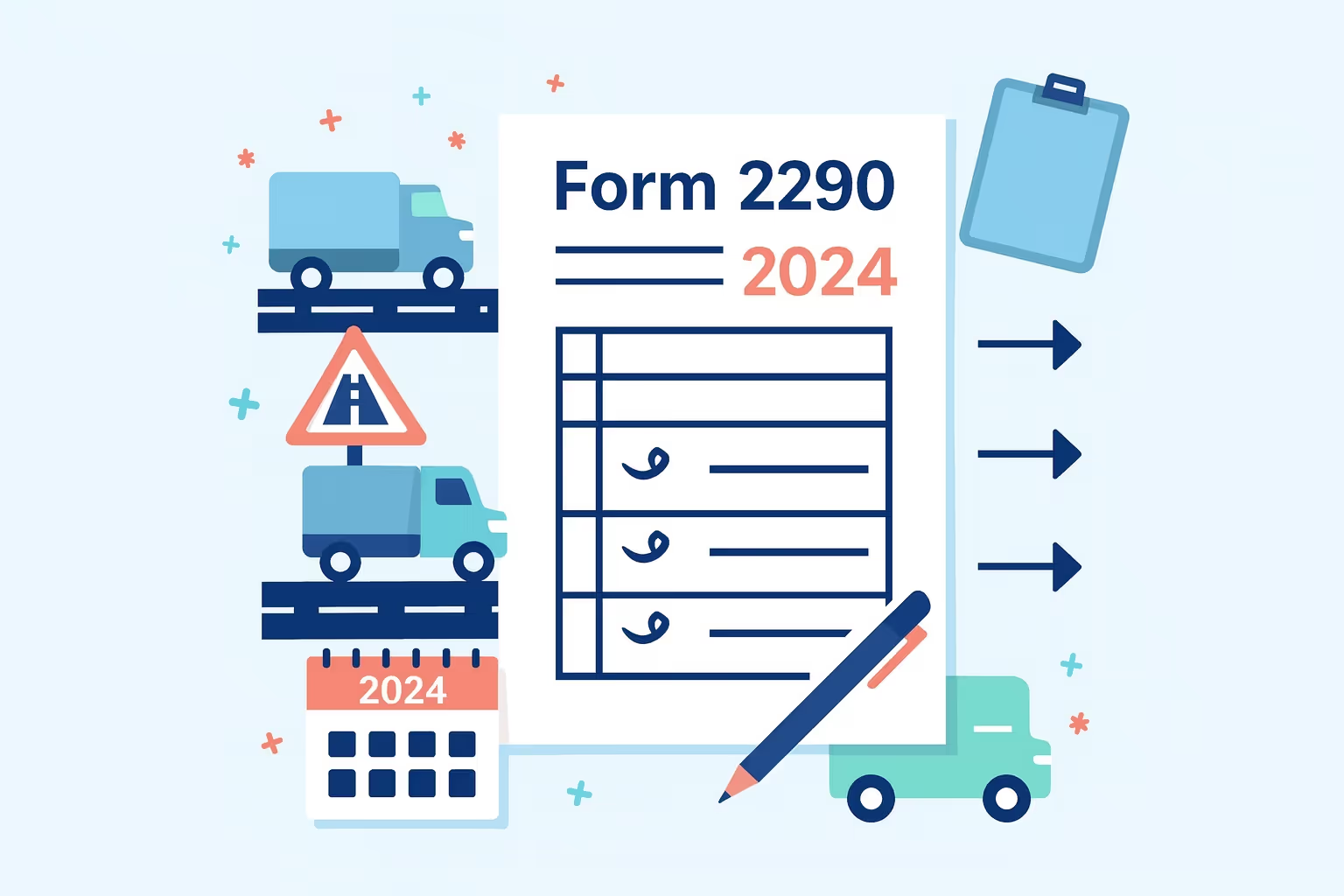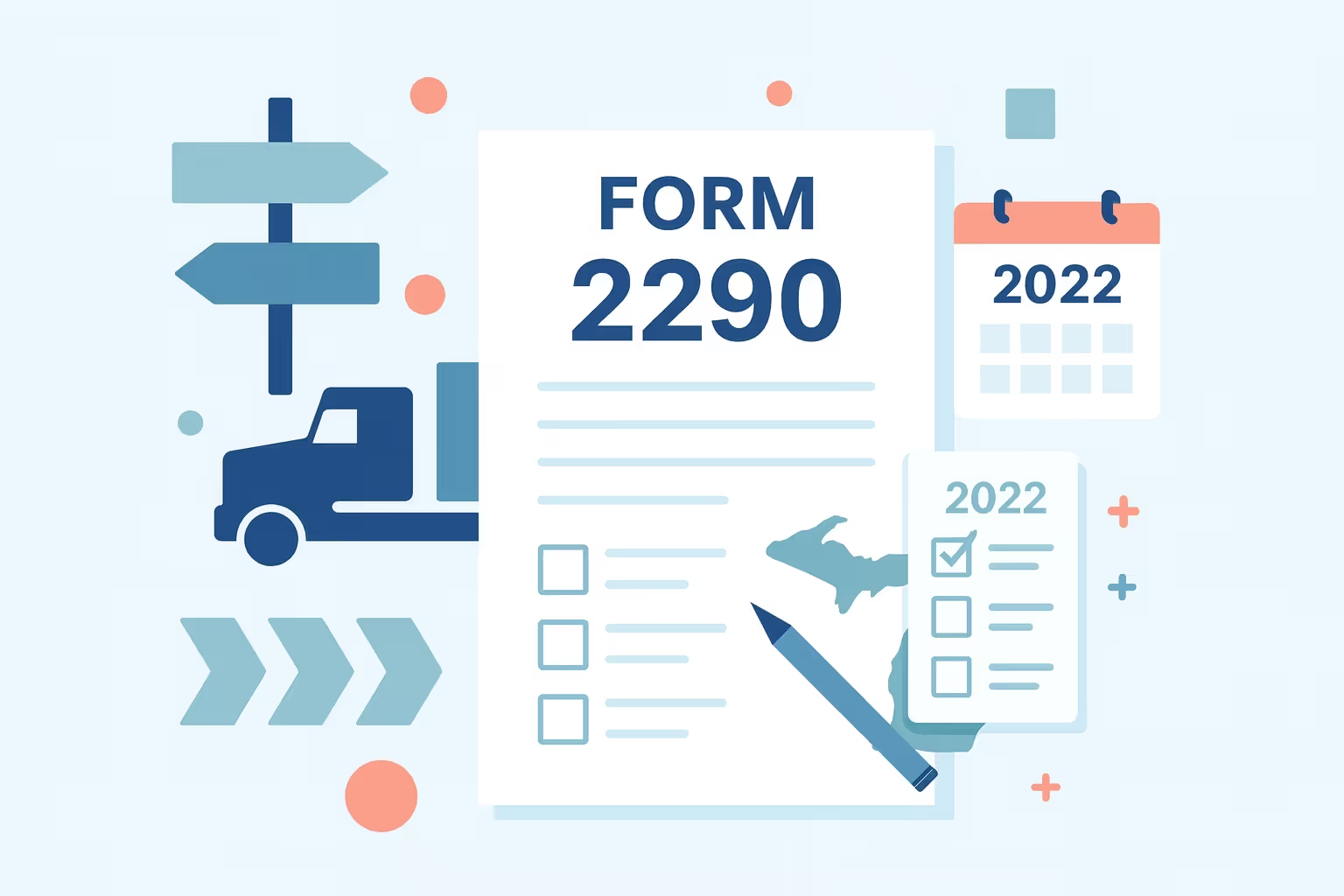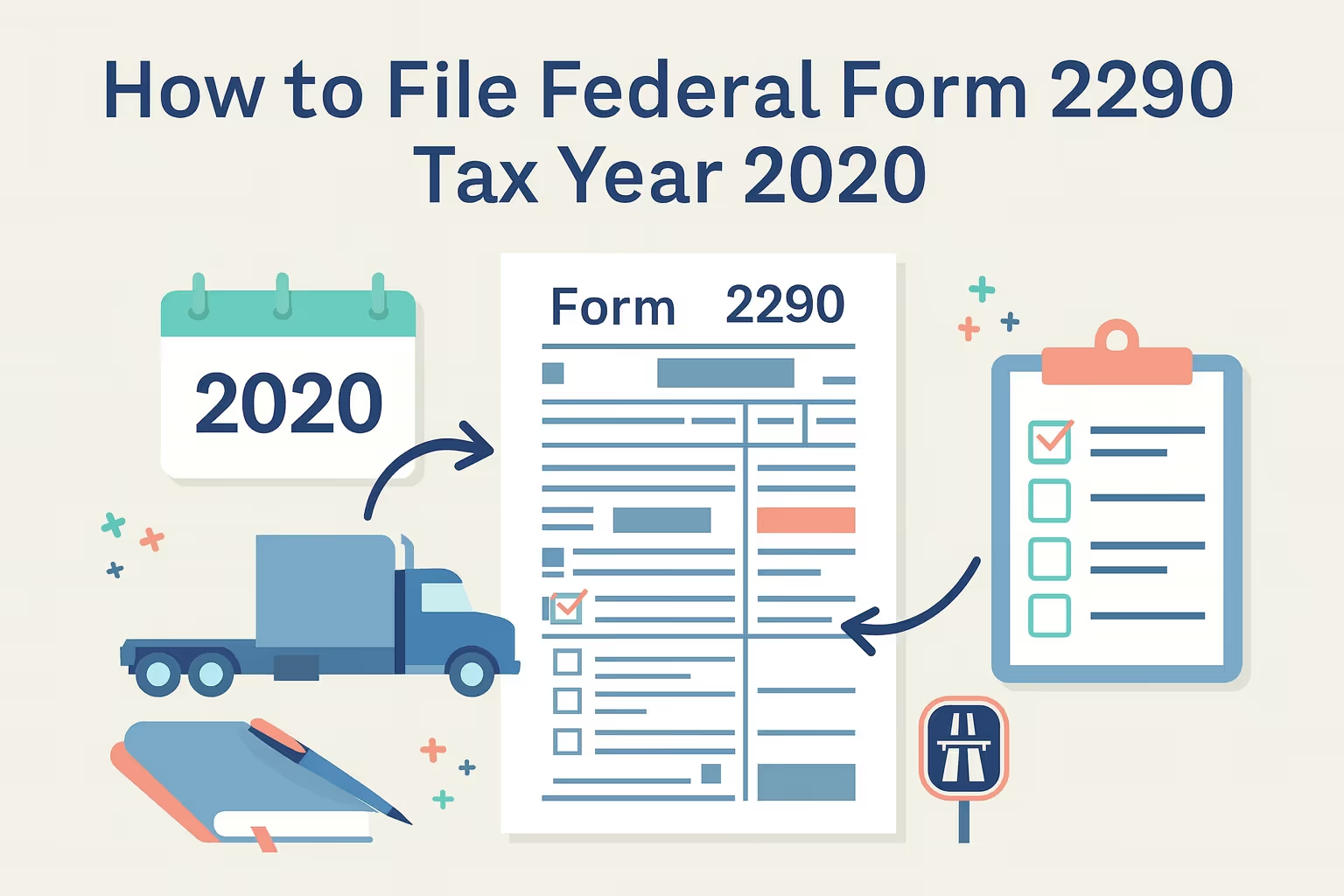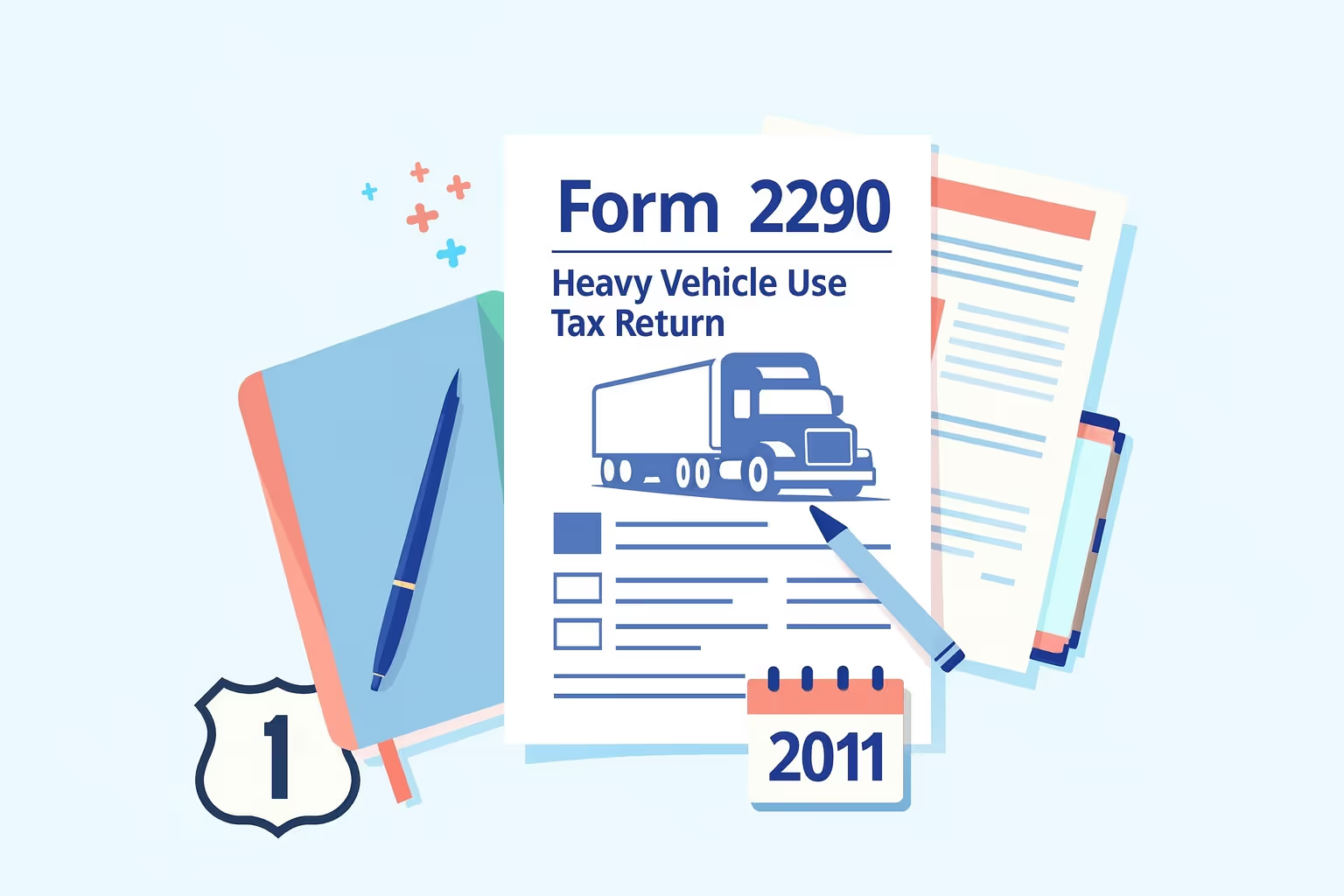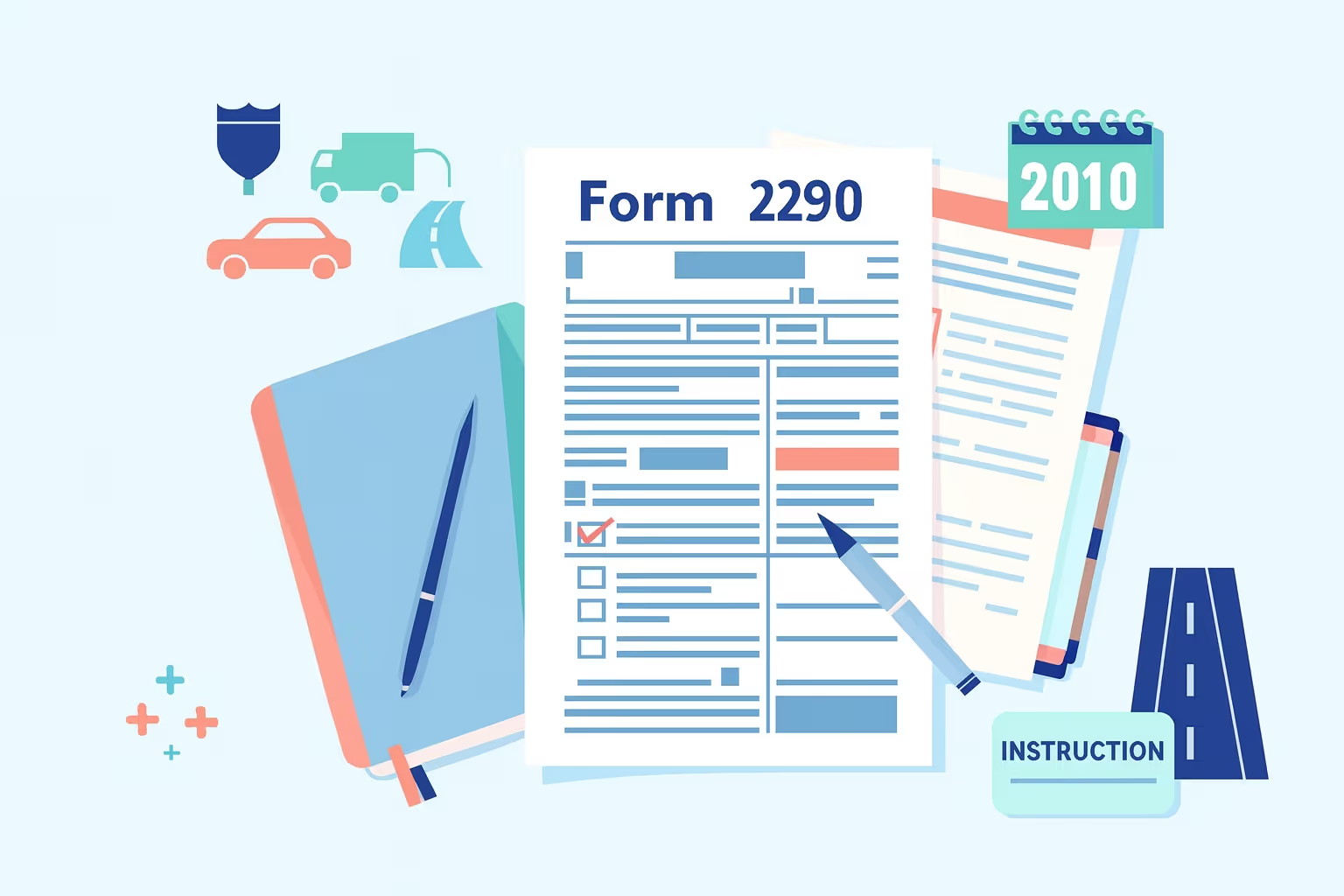Form 2290 2015 Instructions: Step-by-Step Filing Guide
Form 2290 2015 instructions outline the process for reporting and paying the Heavy Highway Vehicle Use Tax to the Internal Revenue Service. This federal excise tax applies to highway motor vehicles with a taxable gross weight of 55,000 pounds or more that operate on public highways during the 2015 tax period, which runs from July 1, 2015, through June 30, 2016. The tax helps fund road construction and maintenance across the United States, making compliance essential for truck owners, fleet operators, and transportation businesses.
The form is used to report each taxable vehicle and calculate the amount of tax owed based on the vehicle’s taxable gross weight. It also allows taxpayers to claim suspension for low-mileage or agricultural cars and to report the acquisition or sale of used taxable vehicles. To ensure proper processing, filers must provide accurate vehicle identification numbers, employer identification numbers, and payment details through accepted IRS methods such as electronic funds withdrawal or money order payable to the United States Treasury.
Filing Form 2290 correctly and on time ensures vehicle registration, prevents penalties, and maintains compliance with federal tax regulations. The following guide explains who must file, how to calculate the heavy vehicle use tax, and the complete steps for electronic filing or paper submission for the 2015 tax year.
Understanding IRS Form 2290
Form 2290 is the official IRS tax form used to report and pay the Heavy Highway Vehicle Use Tax (HVUT). It applies to owners and operators of highway motor vehicles with a taxable gross weight of 55,000 pounds or more that operate on public highways during a given tax period. This federal excise tax helps fund highway maintenance and infrastructure improvements nationwide.
What Form 2290 Is Used For?
- It is used to report the tax due on heavy vehicles operated on public highways.
- It provides proof of tax paid through the stamped Schedule 1, which is required for vehicle registration.
- It allows taxpayers to report the acquisition, sale, or transfer of taxable vehicles.
- It enables eligible filers to claim suspension for vehicles that meet mileage use limit requirements.
Who Must File?
Any individual, business, or organization must file if they:
- Operate a heavy highway vehicle with a taxable gross weight of 55,000 pounds or more.
- Have the vehicle registered, or required to be registered, under their name during the tax period.
- Use the vehicle on public highways, including self-propelled vehicles, logging vehicles, and agricultural vehicles.
Types of Taxable and Exempt Vehicles
- Taxable vehicles: Trucks, truck tractors, and buses that exceed the 55,000-pound threshold.
- Exempt or partially exempt vehicles: Qualified blood collector organizations, certain vehicles owned by the federal government, and vehicles used exclusively for off-highway transportation.
- Suspended vehicles: Vehicles expected to travel 5,000 miles or less (7,500 miles for agricultural vehicles) qualify for suspension.
Key Tax Period Details
- The 2015 tax period spans from July 1, 2015, to June 30, 2016.
- The filing deadline is August 31, 2015, for vehicles first used in July.
- When a vehicle is first put into use later in the tax period, Form 2290 must be filed by the last day of the following month.
- Each tax computation is based on the vehicle’s taxable gross weight and the service customarily performed.
Why Filing Matters?
Filing Form 2290 ensures compliance with IRS regulations and enables vehicle registration at state motor vehicle agencies. Failure to file or pay the tax on time can result in penalties and interest. Properly completed forms provide documentation that the tax reported was paid for each vehicle fully equipped for service.
Understanding these basics prepares taxpayers to complete the form accurately and avoid delays or rejections from the IRS.
What’s New for the 2015 Filing Year?
The 2015 tax year introduced several updates to the rules governing the Heavy Highway Vehicle Use Tax. These changes affected how taxpayers calculate their liability and report information for taxable vehicles. The most significant revisions were made by Treasury Decision 9698, which clarified documentation and computation requirements.
Key Updates Introduced in 2015
- Treasury Decision 9698 required additional information when claiming a credit or refund for a vehicle that was sold, destroyed, or stolen during the tax period. Taxpayers must now provide detailed proof of the event, including its timing.
- The rules for calculating the tax due on a used taxable vehicle were updated. When a car is purchased from a private party, the tax computation must reflect the remaining months of the tax period using the partial period tax method.
- New guidelines were issued for reporting the disposition or transfer of a taxable vehicle. Filers must accurately report acquisition and sale dates to ensure that tax paid is appropriately credited.
- The IRS continued to require electronic filing for taxpayers reporting 25 or more vehicles. However, the agency also strongly encouraged all taxpayers to use e-filing to reduce errors and improve processing times.
These updates ensure better accuracy in reporting and help align the federal excise tax process with evolving electronic filing systems. Taxpayers should review these rules carefully before submitting their 2015 tax return to prevent delays or penalties.
Step-by-Step Form 2290 Filing Instructions
The following steps outline the process for completing the 2015 Form 2290 from start to finish. Each step includes the key details needed for accurate and timely filing.
Step 1 – Determine if Filing Is Required.
- A taxpayer must file if any vehicle operated on public highways during the 2015 tax period has a taxable gross weight of 55,000 pounds or more.
- The requirement applies even if the vehicle is only used occasionally or for a portion of the tax period.
- Vehicles such as buses, trucks, and truck tractors that meet the weight threshold are subject to the heavy vehicle use tax.
Step 2 – Obtain an Employer Identification Number.
- The IRS requires an Employer Identification Number (EIN) for all filers. Social Security numbers cannot be used when submitting Form 2290.
- Taxpayers can apply for an Employer Identification Number (EIN) through the IRS website using the online application system.
- It is essential to allow time for the new number to become active before filing electronically.
Step 3 – Gather Vehicle Information.
Each reported vehicle must have accurate identifying and operational data.
- Include the complete 17-character vehicle identification number.
- Identify the vehicle’s taxable gross weight and its weight category based on the tax computation table.
- Indicate if the vehicle qualifies as a suspended vehicle, logging vehicle, or agricultural vehicle.
- Provide the first month of use during the tax period for each vehicle reported.
Step 4 – Calculate the Taxable Gross Weight.
- The taxable gross weight includes the vehicle’s actual unloaded weight fully equipped for service, the actual unloaded weight of any trailers customarily used with it, and the maximum load customarily carried.
- Tax computation must reflect the total of these components.
- For vehicles registered in multiple states, the declared weight cannot be less than the highest weight declared in any state.
Step 5 – Compute the Tax.
- Use the IRS tax computation table to determine the tax reported for each vehicle.
- Regular highway motor vehicles are categorized as A through V, while category W applies to suspended vehicles.
- Logging vehicles are subject to a reduced rate when used primarily for hauling forest products.
- If a vehicle was acquired or placed in service after July, apply the partial period tax method.
Step 6 – Complete the Form and Schedule 1.
- Enter the employer identification number, business name, and address in the form header.
- Complete Part I to calculate the total tax payment and Part II to identify suspended or exempt vehicles.
- Include both copies of Schedule 1 with all vehicles listed by vehicle identification number. One stamped copy will serve as proof of tax payment.
Step 7 – Review and Sign the Return.
- Verify all details, including totals, vehicle categories, and identification numbers, to ensure accuracy and completeness.
- Sign and date the form in the "Paid Preparer or Third-Party Designee" section, as applicable.
- Keep copies of the completed forms and payment confirmation for records.
Following these steps ensures accurate completion of the tax form and a successful filing. Errors in identification numbers, weight categories, or payment information are the most common reasons for delays.
Filing Options: E-File vs. Paper
Taxpayers can submit Form 2290 either electronically or by mail. Electronic filing is generally preferred because it provides faster processing, fewer errors, and instant confirmation of receipt.
Electronic Filing
- The IRS requires electronic filing for taxpayers reporting 25 or more vehicles during the tax period.
- Filers may choose from a list of IRS-approved e-filing providers available on the IRS website.
- Electronic filing enables immediate tax computation, payment processing through electronic funds withdrawal, and the quicker issuance of the stamped Schedule 1.
- The IRS encourages taxpayers to use electronic filing even for a single vehicle because it reduces administrative errors and mailing delays.
Paper Filing
- Taxpayers with fewer than 25 vehicles may file their return on paper if they prefer not to file electronically.
- Paper returns must include Form 2290, both copies of Schedule 1, and the payment voucher if paying by check or money order payable to the United States Treasury.
- Returns should be mailed to the correct IRS processing center based on whether payment is enclosed.
- Processing times for mailed returns can take up to eight weeks, and the postal service will send the stamped Schedule 1.
Filing Deadlines
- The filing deadline for vehicles first used in July 2015 was August 31, 2015.
- For vehicles placed in service later in the tax period, the due date is the last day of the month following the vehicle’s first use.
- If a vehicle increases in taxable gross weight or exceeds the mileage use limit, an amended return must be filed immediately.
Selecting the correct filing option is essential for timely processing and avoiding penalties. Electronic filing is the most efficient and secure method, while paper filing remains an option for smaller fleets or those who prefer traditional submission.
Payment Methods and Instructions
Form 2290 requires full payment of the Heavy Highway Vehicle Use Tax at the time of filing. The IRS offers several secure payment options to make the process convenient for taxpayers. Choosing the correct payment method ensures the return is processed smoothly and without delay.
Electronic Funds Withdrawal
- This option allows the IRS to withdraw the total tax payment directly from the taxpayer’s bank account when filing electronically.
- It requires a valid checking or savings account, along with accurate bank routing and account numbers.
- The payment is processed on the same date the return is accepted, offering convenience and confirmation of payment.
- This method is available only when filing electronically through an approved e-filing provider.
Electronic Federal Tax Payment System (EFTPS)
- The Electronic Federal Tax Payment System is a free federal system that allows taxpayers to make payments online or by phone.
- Enrollment is required at the EFTPS website, and setup may take several business days.
- Payments can be scheduled up to one year in advance or made for the same day if submitted before the daily cutoff.
- This method provides a confirmation receipt and a secure record of the tax payment.
Check or Money Order
- Taxpayers filing by paper can pay by check or money order payable to the United States Treasury.
- Payments must include Form 2290-V, the payment voucher, which links the payment to the correct return.
- The payment should include the employer identification number, tax period, and the notation “Form 2290.”
- Cash should never be mailed, and taxpayers should allow enough time for postal delivery.
Timely and accurate payment helps taxpayers avoid penalties and interest charges. Regardless of the method chosen, maintaining proof of payment, such as bank confirmations or canceled checks, is essential for future reference and compliance.
Required Schedules and Attachments
Form 2290 requires specific schedules and supporting documents to be considered complete. These attachments provide essential details that verify the tax computation and identify the vehicles being reported.
Schedule 1 Requirements
- Schedule 1 serves as proof of tax paid and must list each vehicle by its complete Vehicle Identification Number (VIN).
- Two copies must be included with each filing. The IRS will stamp and return one copy for the taxpayer’s records.
- The stamped Schedule 1 is required by most state departments of motor vehicles for vehicle registration renewal.
Additional Required Documentation
- A suspension statement is required if a vehicle qualifies for suspension under the mileage use limit rules.
- A report of acquisition or transfer must be attached if the taxpayer acquired or disposed of a taxable vehicle during the period.
- Supporting documents are needed for any credit or refund claim involving destroyed, stolen, or sold vehicles.
- An amended return explanation must be included if additional tax is owed due to an increase in gross weight or if the mileage limit has been exceeded.
Optional Authorization
- Taxpayers may complete the consent section on Schedule 1 to authorize the IRS to share payment information with other government agencies.
- This authorization helps streamline vehicle registration processes at both the state and federal levels.
Providing complete and accurate attachments ensures that the tax return is processed without delay. Missing or incorrect documentation can cause rejections or extended review times by the IRS.
Common Errors and How to Avoid Them
Errors in preparing or submitting Form 2290 can lead to processing delays, penalties, or rejected filings. Understanding the most frequent mistakes helps taxpayers submit a complete and accurate tax return.
Frequent Filing Mistakes
- Using an incorrect or incomplete vehicle identification number prevents the IRS from properly recording the vehicle on Schedule 1.
- Entering a Social Security number instead of an Employer Identification Number (EIN) can cause the form to be rejected.
- Misreporting the vehicle’s taxable gross weight or selecting the wrong category results in inaccurate tax computation.
- Failing to sign and date the return makes it invalid and subject to delay.
- Forgetting to attach Schedule 1 or a payment voucher when filing by paper can prevent the IRS from processing the return.
Recordkeeping and Compliance Errors
- Some taxpayers neglect to retain a copy of their stamped Schedule 1, which is required for registration and future audits.
- Failing to maintain records of tax payments, canceled checks, or proof of electronic fund withdrawals can complicate verification.
- Incomplete mileage logs for suspended vehicles may result in penalties if the IRS requests documentation.
Best Practices to Prevent Errors
- Double-check all numbers, including vehicle identification numbers, employer identification numbers, and gross weight totals, to ensure accuracy.
- Use electronic filing whenever possible to benefit from automatic error checks and immediate confirmation.
- Review all entries carefully before signing and submitting the form.
- Keep all records for at least three years after the due date of the return or payment date, whichever is later.
Taking the time to review all details before submission ensures a smooth process and helps maintain compliance with federal tax regulations. Accurate filing also protects the taxpayer’s right to register and operate vehicles legally on public highways.
Special Situations: Zero Activity, Suspended, or Final Returns
Certain taxpayers may not have taxable vehicles to report for a given year or may need to close out operations. Understanding how to handle these special filing situations ensures compliance and proper recordkeeping with the IRS.
Filing a Final Return
- A final return must be filed if a business permanently ceases operations, sells all taxable vehicles, or dissolves.
- The taxpayer should check the “Final Return” box on Form 2290 and report any tax due for vehicles used before the date of sale or closure.
- Schedule 1 should still list all vehicles used during the tax period, even if they are later sold or transferred.
No Filing Requirement
- If the business does not own or operate any vehicles with a taxable gross weight of 55,000 pounds or more, no return is required.
- Records should still be retained to prove that no taxable vehicles were in use during the tax period.
- Vehicles that are exempted, such as those used solely for off-highway transportation or owned by the federal government, do not require a return.
Suspended Vehicles and Mileage Limits
- Vehicles expected to travel 5,000 miles or less (7,500 miles for agricultural vehicles) qualify as suspended vehicles.
- Taxpayers must complete the suspension statement section in Part II of the form to claim suspension.
- If a vehicle exceeds the mileage use limit during the tax period, an amended return and full tax payment are required for that vehicle.
Seasonal and Partial Period Use
- If a vehicle is placed in service after the start of the tax period, a partial period tax applies based on the first month of use.
- The same rule applies to vehicles that are temporarily removed from service and then reactivated within the same tax year.
- Taxpayers should report the acquisition and disposition dates to ensure accurate prorated tax computation.
Properly addressing these special situations ensures that tax liability is accurately reported and helps avoid IRS correspondence or penalties in the future.
Understanding the IRS Stamped Schedule 1
The stamped Schedule 1 is one of the most critical documents received after filing Form 2290 successfully. It serves as proof that the heavy vehicle use tax was paid or that a suspension was claimed correctly.
Purpose and Importance of Schedule 1
- The stamped Schedule 1 verifies that the taxpayer has fulfilled the tax obligation for all vehicles reported on Form 2290.
- Most state motor vehicle departments require the stamped copy to renew or register heavy highway vehicles.
- The document includes the employer identification number, name, address, and vehicle identification numbers for each reported vehicle.
How to Receive Schedule 1?
- Taxpayers who file electronically receive a digitally stamped Schedule 1 within minutes of IRS acceptance.
- Those who file by paper will receive a stamped copy by mail after processing, which may take up to eight weeks.
- If a payment was made by check or money order, the canceled check can serve as temporary proof of tax paid until the stamped Schedule 1 arrives.
Replacing or Reprinting Schedule 1
- If the original Schedule 1 is lost, a taxpayer may request a replacement by contacting the IRS or their e-filing provider.
- Digital copies can be downloaded from the provider’s portal or emailed again upon request.
- A previously filed Schedule 1 can also serve as a reference for the next tax period when re-filing for the identical vehicles.
Maintaining an accessible copy of the stamped Schedule 1 ensures continued vehicle registration and compliance with both IRS and state requirements. It is recommended that taxpayers keep the document with their tax records for at least three years.
Frequently Asked Questions
What are the key details in the Form 2290 2015 instructions?
The Form 2290 2015 instructions explain how owners and operators of highway motor vehicles with a taxable gross weight of 55,000 pounds or more must file and pay the Heavy Vehicle Use Tax. The tax period runs from July 1, 2015, to June 30, 2016, and applies to vehicles operated on public highways. The guide includes information on tax computation, electronic filing, and proof of tax paid through Schedule 1.
Who must file Form 2290, and what vehicles are taxable?
Any individual or business that operates highway motor vehicles weighing 55,000 pounds or more during the tax period must file Form 2290. Taxable vehicles include self-propelled vehicles such as trucks, truck tractors, and buses. Agricultural vehicles and logging vehicles may qualify for reduced rates or mileage suspension. Vehicles exempted from the federal excise tax include those owned by the federal government or qualified blood collector organizations.
How is the heavy vehicle use tax calculated for taxable vehicles?
The tax computation is based on the vehicle’s taxable gross weight, which includes the actual unloaded weight of the vehicle fully equipped for service, the actual unloaded weight of any trailers customarily used with it, and the maximum load customarily carried. Taxpayers use the IRS tax computation table to determine the correct amount due. Additional tax applies if a vehicle increases in taxable gross weight during the tax period.
How can taxpayers make a secure tax payment to the IRS?
Taxpayers may pay the heavy vehicle use tax through electronic funds withdrawal when filing electronically, through the Electronic Federal Tax Payment System, or by sending a check or money order payable to the United States Treasury. The payment voucher Form 2290-V must be included when paying by mail. The IRS encourages taxpayers to use direct debit for secure and same-day processing.
What happens when a taxable vehicle is sold or acquired mid-year?
When a taxable vehicle is acquired after the start of the tax period, the taxpayer must report the acquisition details and calculate the tax using the partial-period tax method. The tax reported depends on the month the vehicle falls into use. If a vehicle is sold or transferred, the seller may be eligible for a credit or refund of tax paid on the remaining months, provided that the transaction is supported by appropriate documentation.
















